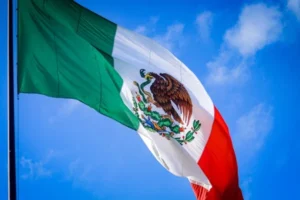The Soumaya Museum was inaugurated on March 29, 2011 with the assistance of personalities from politics, culture and the arts, both national and international. It was preceded by the museum that was inaugurated in 1994 in Loreto Square in the south of the city, changing its headquarters after 17 years. It is concretized as an ambitious project with an independent building. Its prospect for the future, comes to give a new urban reading to that old industrial area. With its cultural programming and contemporary architectural design, one of the most beautiful in the world conceived as a monumental sculpture, it completely changed the urban vision of that part of the city. It becomes the epicenter of the social dynamics that take it beyond the commercial for all the institutional activity it raises. Hence, it marks a before and after within the history of avant-garde Mexican architecture.
Origins of the Project
It was projected as the leading avant-garde building of the new Mexican architecture. This project was undertaken by the architecture studio Free in charge of the architect Fernando Romero. Its conception started as a philanthropic work of the Mexican billionaire businessman Carlos Slim. His motivation was that art should be available to all Mexicans since the common cannot travel to see the art collections in the great museums of the world, then he would be offered the opportunity to appreciate it for free. Bringing great historical works of art to low-income people who could hardly see art outside of Mexico was his mission. Its construction aimed to preserve and disseminate the art collection of the Carlos Slim Foundation summarized in more than 30 centuries of American and European art. Its name is in homage to the businessman’s deceased wife.
Design
In this commercial area, the Soumaya Museum stands out as a monumental abstract sculpture of a surrealist nature. Its bright silver appearance is given by the conjunction of 16000 aluminum hexagones in an asymmetrical façade with a single opening that functions as a door that gives entrance to the enclosure. Its surface consists of 17,000 square meters and with a height of 46 meters. It is a structure formed by 28 steel columns of different thickness curved and crossed by beams that give it stability.
This results in a very striking complex geometry with overhangs on the sides product of the beams and that is secretly camouflaged by its silver façade that simulates being suspended in the air. Many have called her “a moving trapezoid”, perhaps Jean Arp’s The Cloud Shepherd runs after her knowing she is lost. Its apparent mobility gives it a changing appearance according to the time and according to the point of view of the observer. The outdoor area surrounding the entrance functions as a visitor square that connects with the Carso complex next to the place and crowns with a large staircase that gives access to the museum.
Inside there is an absence of central columns so it consists of large spaces or rooms that facilitate the movement of visitors around each of the exhibited pieces. It is a building that consists of six floors which is accessed by elevator or by a spiral-shaped ramp that borders the perimeter and allows wheelchair access. The top floor is the largest with a translucent roof that illuminates the enclosure with the passage of natural light. Passing into the entrance hall Rodin’s Thinker welcomes you in a spacious clean room or lobby. The Museum also consists of public and private surrounding areas such as an auditorium with capacity for 350 people, a library, a restaurant, a souvenir shop and offices.
Carlos Slim Foundation Collection
The Soumaya Museum houses the private art collection of the Carlos Slim Foundation. The museum preserves and exhibits a varied and eclectic collection of Mexican and European art. 70,000 pieces of art are distributed throughout the six rooms that make it up, with Auguste Rodin’s being the most visited. This collection is the most important outside France, the sculptor’s country of origin. It also houses Renaissance and Baroque pieces by painters from European schools such as Flemish, French, Italian, Spanish, German. The collection is also made up of Mexican pre-Hispanic pieces from the preclassic, classical and postclassic periods. Masks, ceramics, clay statuettes, vessels, utensils and pieces that were part of the Amerindian cultures that expanded throughout the Mexican territory.
Many of them are under the figure of commodity by the National Institute of Anthropology and History of Mexico. No less important are the artists who expressed themselves in the viceregal era with a mestizo art, typical of cultural syncretism product of the meeting of two worlds such as Cristóbal de Villalpando, Juan Correa, Miguel Cabrera, Nicolás Enriques and José de Páez, as well as religious painting, sculptures, oils and portraits as well as utensils, furniture and silverware of the time. It is noteworthy that the Viceroyalty of New Spain established the city as a zone of commercial exchange between Asia, America and Europe. Many objects and pieces resulting from this commercial exchange are preserved in the Museum such as furniture, screens, watches, jewelry, music boxes. Also important works of the school that began landscaping in Mexico with the masters Eugenio Landesio and José María Velasco.
It is noteworthy that the permanent exhibition rooms with masters of contemporary art are the most visited of the entire museum. This collection is adorned with the Mexican art of the twentieth century with masters such as Rufino Tamayo, Juan Soriano, José Luis Cuevas or Francisco Toledo. In addition to exhibitions of European masters of Impressionist art such as Pierre-Auguste Renoir, Claude Monet, Edgar Degas. Pablo Picasso, Salvador Dalí, Joan Miró, Vicent Van Gogh, Tolouse-Lautrec are the ones who complement the most important artists seen in the museum’s permanent exhibitions.
The initial lobby is the large clean room that welcomes the visitor with works of universal significance such as The Thinker and The Gate of Hell by Auguste Rodín; Río Juchitán, the last mural by the Mexican painter Diego Rivera; Still Life and Day and Night by Rufino Tamayo; and the Pietà, a bronze-cast replica of Michelangelo Buonarroti’s original.
The museum has to its credit the most extensive numismatic collection in Mexico with 1260 pieces of gold and 1185 pieces of silver minted since 1732. The Foundation always seeks to expand its collection by buying from auction houses such as Christie’s and Sotheby’s in order to recover part of the Mexican artistic heritage to exhibit it and make it known to the people in addition to fulfilling research, preservation and restoration activities. Its collection is also expanded by donations made by personalities such as coins and medals of the Second Mexican Empire by Floyd Ganassi; more than 300 pieces of ivory gathered and donated by Mrs. Laura Fernández McGregor Maza.
Rodin in the Soumaya
Auguste Rodin’s collection is on permanent display and is the most important outside of those on display in his native France. In the lobby is the cast iron replica of his work The Gate of Hell. Of his iconic works, in addition to The Thinker, are The Kiss, The Mask of the Man with the Broken Nose, The Bronze Age and The Burgesses of Calais. This collection is called The Age of Rodin and is exhibited together with works by other artists disciples of the sculptor: Daumier, Carpeaux, Claudel, Boucher and others. We also find the mythological works The Death of Adonis and The Metamorphosis of Ovid. Undoubtedly, the Carlos Slim Foundation has taken over one of the most important collections of European Neoclassical sculpture with the master Rodin.
Twentieth-Century Mexican Art
Within the collection of the Soumaya Museum there are also masters who were inspired by the European avant-garde and who come from the post-revolutionary generation, the one that aspired to a more equitable and fairer society raising awareness through an art of social denunciation. The artists Gerardo Murillo, Diego Rivera, José Clemente Orozco, David Alfaro Siqueiros, Rufino Tamayo and Jorge González Camarena belong to the Mexican muralist current. They were creators of large-format works having as a canvas the walls of the city, but at some point they left their natural city space to be part of the artistic heritage that the museum preserves.
To his credit he also owns the collection of Self-Portraits of Mexican Painters belonging to the engineer, collector and cultural promoter Marte R. Gómez. In it there is also the generation of artists called La Ruptura: Gunther Gerzso, Juan Soriano, José García Ocejo and José Luis Cuevas as well as the oaxacan artists Francisco Toledo and Sergio Hernández.
Minor or Applied Arts
The manifestations of the applied arts also have their place in the Souyama Museum. Fashion and textile expressed in apricots, silks, satins and velvets as well as dresses, intimate clothing, accessories, jewelry ranging from 1780 to 1950, years that cover the eighteenth, nineteenth and twentieth centuries and belong to the museum collection. Also Photography as applied art that exposes its beginnings with the first daguerreotypes, ferrotypes, platinotype, collodion and albumins of the mid-nineteenth century as well as cameras and phototypes.
The large spaces of this museum were also conceived to also comply with social responsibility and multiply the appreciation and valuation of art in schools and lyceums, Various programs are executed in alliance with educational centers to promote and encourage the appreciation of art in children and adolescents linking it with the school curriculum.
The Carlos Slim Foundation made a dream come true, that of conceiving an avant-garde space that energizes the city. The Soumaya Museum with more than 30 centuries of art to its credit is a mandatory reference for those who wish to observe collections of great masters of world plastic arts. If you come to Mexico it is a must to take a good dose of art and ingenuity.










